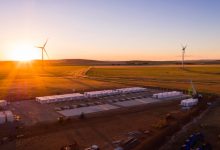The Tesla big battery at Hornsdale in South Australia – already the world’s biggest lithium-ion battery installation – has been given regulatory approval for its expansion, with testing for the bigger battery expected to commence in the next two weeks.
The approval was announced late Thursday by the Essential Services Commission of South Australia approving a variation to the licence of the Hornsdale Power Reserve – the battery’s official name – to increase its size from 100 megawatts to 150 megawatts.
Its full dimensions will expand from 100MW/129MWh to 150MW/194MWh, with the additional storage scheduled to be used to provide “synthetic inertia” and help deliver even more of the grid services traditionally supplied by fossil fuel generators.
The expansion of the Hornsdale battery is a key component of the South Australia Liberal government’s plan to reach its target of net 100 per cent renewables by 2030. The Hornsdale battery is one of three operating big batteries – along with Dalrymple North and Lake Bonney – with others in the pipeline.
The S.A. commission said it undertook a round of public consultation in relation to the application and received no submissions from stakeholders.
“The Commission assessed Hornsdale Power Reserve Pty Ltd’s application for an electricity generation licence against the relevant provisions of the Electricity Act 1996 and the Essential Services Commission Act 2002 and determined that all relevant criteria under those Acts have been satisfied. It has therefore approved the application,” it said in a brief statement.
It is expected that formal testing of the expanded battery, which will deliver a range of new services, and which has been supported by the state government, ARENA and the CEFC, will begin soon. It had hoped to be on line in March with the expanded capacity, which was first announced last year.
Curiously, the commission also published a statement saying that the Lincoln Gap wind farm, the site of a proposed 10MW/10MWh battery, had withdrawn its application for a variation of its licence.
RenewEconomy understands this is a procedural matter pending an application to change the turbine supplier for the neighbouring Lincoln Gap wind farm near Port Augusta. The battery has been installed, but not yet commissioned.
The Hornsdale battery, meanwhile, has been a resounding success, both for the state government that helped underwrite its construction by signing a 10-year $40 million contact to supply emergency back-up, for the grid operator which has found it has played a critical role in keeping the lights on, as well as to consumers and the owners itself.
Hornsdale owners Neoen recently announced that the battery had delivered a five-fold increase in revenue in the first quarter of 2020, primarily from its key role in supporting the state grid when it was operating as an “islanded” after a major storm tore down the main transmission line that links it to Victoria. The market operator said the big batteries played a critical role in keeping the lights on.
Neoen has also said that the battery has delivered more than $150 million in cost reductions to the networks from its interventions in the frequency control market, which had traditionally been dominated by the incumbent gas generators.










